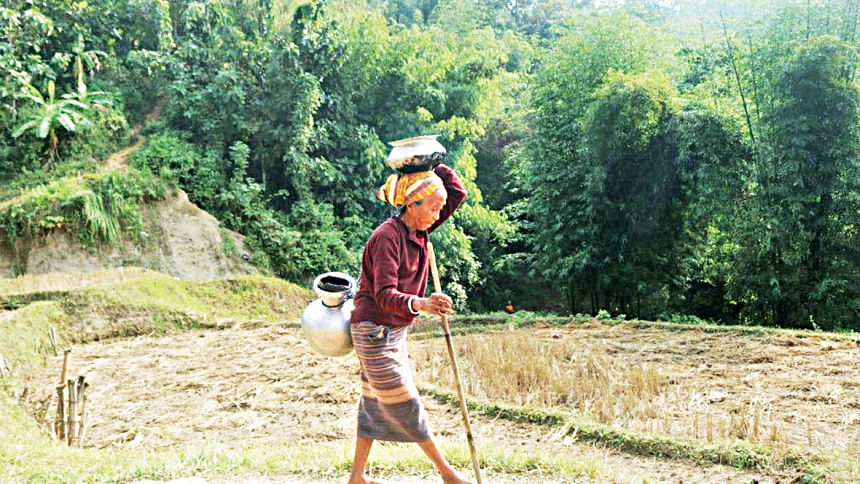Water woes worsen in CHT

The wars of the 21st century will be fought over water, the former World Bank Vice-President Ismail Serageldin had predicted in 1995. And a recent visit to the Chattogram Hill Tracts suggests the region is inching that way.
People are migrating internally to various locations due to the water crisis in the region thanks to a combination of climate change and capitalism -- a development that may invite conflict in the region, according to local representatives and non-governmental organisations.
Take the case of Piyanmoi Pankhuya, a dweller of Maini of Longodu area in Rangamati, where he moved his family from his ancestral village of Zandimon in Bilaichhari upazila of Rangamati last year for lack of drinking water.
Each morning, for about a decade, the 45-year-old would travel five kilometres through the rugged steep hills with a 5–litre jerry can in tow to fetch drinking water from a stream for his four-member household.
Then last year, he noticed the water in the stream was dwindling fast -- so much that he could not fill his container.
"As long as there was water, I did not mind taking such a long journey. But I saw the stream drying up in front of my eyes. You can endure many difficulties but you can't live without water. So, I decided to relocate my family elsewhere," Pankhuya told The Daily Star.
An official figure on internal displacements such as Pankhuya's family is hard to come by, but on The Daily Star's visit to six remote areas of the Hill Tracts, at least 50 families were found who had shifted in pursuit of safe drinking water.
"The water crisis is the biggest concern in the remote areas now," said Apu Chowdhury, chairman of Khagrachari District Council.
Several hundred streams and springs in Rangamati, Khagrachhari and Bandarban districts that the locals relied on for water are no longer flowing like before.
The crisis emerged due to climate change coupled with deforestation, stone extraction from streambeds used to provide hilly people with water, Chowdhury said.
"In the dry season, the situation turns the worst. We distributed water in various areas by trucks," he said, adding that the Khagrachari District Council has taken up an awareness campaign on forest conservation in 65 areas.
The natural ecosystem in CHT has been disturbed, said Kamal Hossen, a professor at the Institute of Environmental Science of Chattogram University.
About 80,000 hectares of forest land have been lost to deforestation in the last five years, according to Hossen.
With the damage to the ecosystem, the watershed -- an area of land that drains all the streams and rainfall to a common outlet -- of the hilly region has disappeared, drying up streams and springs, he added.
And due to global warming, the pattern of rainfall in CHT has changed from unimodal to bimodal.
A unimodal wet season is one in which there is only one rainfall peak (i.e., no alternation of humid and dry months within the wet season). A wet season with two rainfall peaks, separated by at least one dry month, is bimodal.
At the beginning of the monsoon, the rainfall lasts a few days with a long pause in the middle of the season. The penultimate day in the season sees precipitation.
Kazi Humayun Rashid, an assistant meteorologist and the in-charge of the Rangamati Meteorology Office, said the rainfall pattern changed to the extent that it sometimes contradicts their forecast.
"There was an abnormal downpour in 2017 when 343 millimetres of rainfall were recorded in 24 hours triggering a massive landslide across the region. But the following year the rainfall was less than it was forecasted."
In the rainy season, the number of rainless days is increasing, Rashid said, adding that the pattern was bimodal during 2019 and 2020.
Munsi Rashid Ahmed, chief scientific officer of Hill Agriculture Research Centre, said he has been observing a change in weather patterns since his joining in 2016.
"When there is a change in the pattern, the hardest hit will be the agriculture in a region where 90 percent of the population make a living on agriculture."
Agriculture in the hilly region is solely dependent on a steady downpour, he said, adding that steps have been taken for storing rainwater for the dry season.
"But more focus is required to address the crisis. Or else, time will run out soon to stave off the looming danger," he said, adding that the natural coverage of forests and the streams and springs of the hills have reduced to an alarming extent.
To mitigate the crisis, the United Nations Development Programme in cooperation with the Danish International Development Agency took up a project in 2018 titled "CHT Climate Resilience Project".
The project has been using multiple technologies -- the gravity flow system, the infiltration gallery system, water lifting through solar energy and community water supply by solar power -- to support a total of 107 villages under 10 upazilas of Rangamati, Khagrachhari and Bandarban, according to its officials.


 For all latest news, follow The Daily Star's Google News channel.
For all latest news, follow The Daily Star's Google News channel. 



Comments